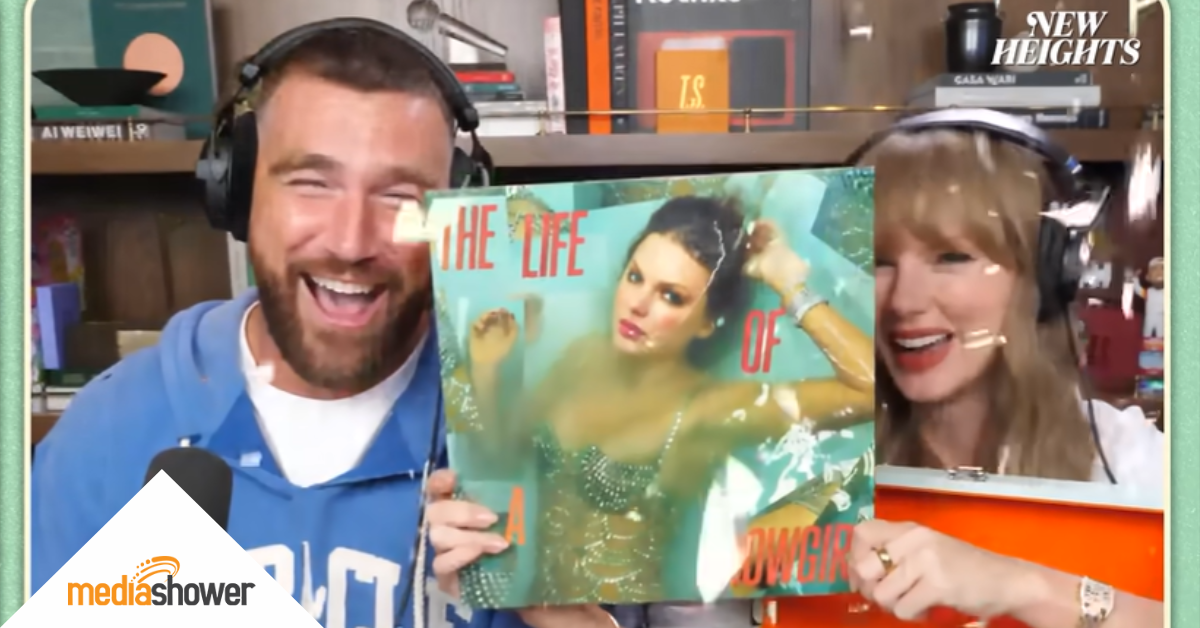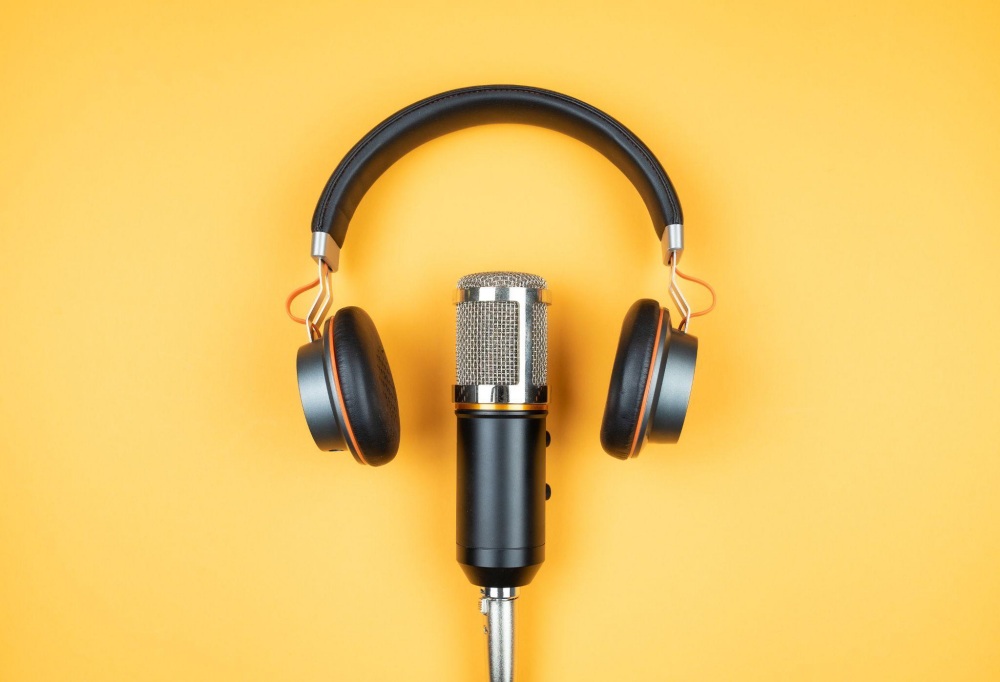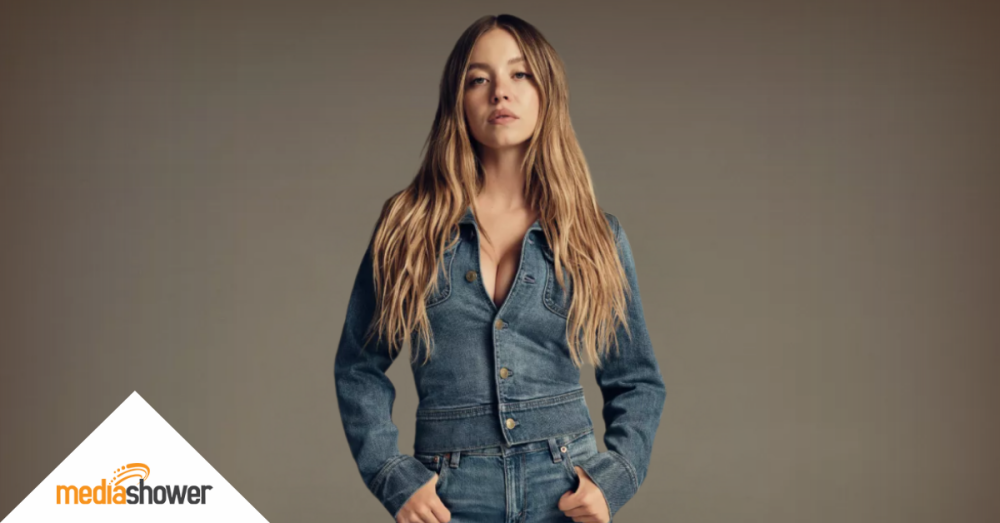
When Taylor Swift and boyfriend Travis Kelce dropped a surprise podcast episode on Kelce’s podcast “New Heights” on August 13, 2025, the internet shattered into a million shareable soundbites.
After months of tabloid headlines and paparazzi photos, the couple were ready to set the record straight. By choosing their own turf to have the conversation, they bypassed the media machine entirely, creating a moment so genuine it sent shockwaves across the internet.
Capping off the historic event, Swift used the platform to make her own major announcement, officially revealing that her 12th studio album, titled “The Life of a Showgirl,” is set for release on October 3rd, 2025.
Insane Social Impact
The episode was an instant cultural event that shattered digital records. The livestream YouTube video pulled in a peak of 1.3 million concurrent viewers, a surge so massive it temporarily crashed the channel’s servers.
Within 24 hours, the episode had amassed 13 million views on YouTube alone. The shockwaves extended across social media, where related clips generated a breathtaking 379 million views on Instagram, 61 million views on X, and 34.5 million on TikTok.
Swift’s appearance also drove a 3,000% increase in new listeners to Kelce’s podcast and a 2,500% spike in average streams for the podcast on Spotify. Female listenership on Spotify increased by 618% in 24 hours. The overall New Heights podcast subscriber base on YouTube jumped by over 500,000, reaching more than 3 million.
For marketers who were paying attention, the moment was a blueprint. Swift and Kelce demonstrated how podcasting, when done right, can become one of the most effective content distribution strategies.
Podcasts Are the New Broadcast
Celebrity podcast moments aren’t new, but this one was different in scale and execution. The Swift episode wasn’t promoted heavily in advance, yet it dominated both mainstream and social media within hours.
Rather than being locked into a walled garden or exclusive format, it was accessible across major platforms. The content was short enough to be consumed on the go, but memorable enough to inspire millions of shares.
From a marketing perspective, the approach checked all the boxes: audience alignment, frictionless distribution, and content that felt authentic. Fans didn’t need a subscription to hear it. They just needed to click play.
The lesson here was something every brand can learn from: When your audience is already listening, sometimes all you need is the right format and the right timing.
The entire YouTube video, August 13, 2025.
Podcasting by the Numbers
Podcasts have evolved far beyond niche hobbyist shows. Over the past five years, they’ve become a core part of how audiences consume content—and how marketers distribute it.
While your team debates whether to post three times or five times a week on LinkedIn, the smartest brands have already moved on. They’re building audiences through a medium that commands 45 minutes of undivided attention at a time.
Audio has become the new front page of the internet:
- There are now 135 million monthly American podcast listeners, representing 47% of the US population age 12+.
- The average American now spends 104 minutes per day listening to digital audio, up from 86 minutes just two years ago.
- Podcast ad revenues in the US surpassed $2 billion in 2024, with forecasts predicting growth to $2.51 billion for 2025 and over $3 billion by 2028.
- In Q1 2025, 64% of audio listening was on ad-supported platforms.
These are the new realities of content marketing.
“Podcast listeners are not only more diverse, but also deeply engaged, spending an average of over 30 minutes per episode, far higher than most digital content.” – GrowthCurve
Why Brands Are Going All-In
Unlike other formats, podcasting offers a combination of flexibility and depth. People listen while commuting, cooking, or exercising. They tune in weekly. They finish episodes.
And they remember what they hear.
For marketers, that creates a rare opportunity: a format where audiences are truly engaged, rather than scrolling past or clicking away. Completion rates are as high as 80%, far higher than blog posts or short-form video.
And because podcasting still feels personal and conversational, listeners are more likely to develop long-term loyalty to the brands or voices behind the mic.
This phenomenon is impacting how brands are investing. HubSpot has built a full podcast network. McKinsey uses its “Forward Thinking” podcast to deepen its credibility with business leaders.
Even traditionally visual brands are branching into audio because it builds trust over time.
Where to Publish: Spotify, Apple, or SiriusXM?
As the podcasting landscape matures, so do the choices for where to distribute your content. The big three—Spotify, Apple Podcasts, and SiriusXM—each offer distinct advantages. Understanding these can help marketers position their content more effectively.

Spotify
Spotify has emerged as a leading player, especially among younger audiences. It offers deep integration with social platforms, in-depth analytics, and built-in monetization tools. It also supports video podcasts and has a large share of podcast consumption globally.
Many brands choose Spotify as their default because of its scale and marketing capabilities.

Apple Podcasts
Apple, meanwhile, remains a go-to for many listeners, especially those embedded in the Apple ecosystem. It’s built into iPhones and iPads, making it easy to discover and subscribe to shows.
While it lacks some of the monetization features of Spotify, it excels at passive discovery and is still one of the top destinations for podcast listening.

SiriusXM
SiriusXM occupies a different space: a curated, premium environment often favored by celebrities and high-end media properties. With the acquisition of Stitcher and other podcasting platforms, SiriusXM has signaled that it’s not just for satellite radio anymore.
While its reach may be smaller than Spotify or Apple, its audiences tend to be more loyal and willing to pay for premium content.
Each platform has its place. In many cases, brands don’t need to choose just one. Most podcast hosting tools support distribution to all three.
The key is understanding your audience and tailoring your promotion strategy accordingly.
Spotify vs. Apple vs. SiriusXM: A quick breakdown
Understanding each platform’s strengths and limitations helps you make strategic decisions about where to focus your efforts. Here’s how the major players stack up:
Matching Platforms to Marketing Goals
Choosing a platform becomes easier when you work backward from your business objectives.
B2B marketers
Open platforms like Spotify and Apple Podcasts allow for broad reach and easy discovery are perfect for syndication and reaching decision-makers.
B2C brands
For those targeting younger or more mobile audiences, Spotify stands out. Its deep social integration and mobile-friendly interface make it easy to share content where your audience already spends time.
And with Spotify’s dynamic ad insertion tools, you can experiment with monetization even as you build an audience.
Luxury brands
If your brand leans toward luxury, niche markets, or exclusive experiences, SiriusXM might be worth exploring. While its reach is more limited, the audience is often more engaged and accustomed to premium content. Partnering with the right host or network can lend additional credibility.
The key: Know your audience
Regardless of platform, the real differentiator is how well you understand your listener. What are they looking for? When and how do they consume content? Are they searching for information, entertainment, or both?

Building a Distribution-First Podcast Strategy
Every successful podcast begins with a purpose. Before choosing a format, inviting guests, or designing your artwork, ask yourself: What role will this podcast play in your overall marketing strategy?
Define your goal before you record
Your podcast should serve a clear business objective. Defining this from the start will shape your content, tone, frequency, and promotion plan.
If your goal is brand awareness: Focus on topics your audience cares about—even if they aren’t directly tied to your product.
- A lifestyle brand might explore themes like creativity, sustainability, or personal development.
- A B2B company could focus on emerging industry trends or customer stories.
- The aim is to build trust and familiarity through content that resonates.
If your goal is lead generation: Use subtle, value-driven calls to action.
- Mention downloadable resources or gated content.
- Encourage newsletter signups or free trial links.
- Keep episodes structured and tied to your marketing funnel.
If your goal is thought leadership: Position your brand as a credible voice in your space.
- Feature expert interviews and relevant commentary.
- Share proprietary research or behind-the-scenes insights.
- Maintain consistency in both content quality and publishing schedule.
Once your goal is clear, every decision—from episode topics to guest selection—should reinforce it.
Build your content with distribution in mind
Think of each podcast episode as a central asset that can fuel multiple forms of content. You’re not just publishing audio—you’re building a distribution engine.
Below are examples of ways to convert every episode.
| Content Type | Best Platforms/Uses |
| Short social media clips | LinkedIn, Instagram, or TikTok |
| SEO-optimized blog summaries | Capture search traffic |
| Quote graphics | Email newsletters or social sharing |
| Audiograms | YouTube Shorts or Instagram Reels |
| Pull quotes | Case studies, sales decks, or presentations |
This multi-channel approach reinforces your message across formats your audience already uses. It also extends the shelf life of each episode, allowing you to get weeks of value from a single recording.
Extend the impact beyond the episode
Distribution-first podcasting is about maximizing return on content. When you plan your podcast with post-production and promotion in mind, you create a system that delivers ongoing value.
Use these tips to boost distribution without extra effort:
- Design episodes with shareable sound bites in mind.
- Include a clear CTA (but keep it soft and conversational).
- Share highlights via email, blog, and social media.
- Encourage guests or partners to amplify reach.
- Track performance across platforms to refine your approach.
When you shift your mindset from “create and post” to “create and distribute,” you’ll see greater reach, deeper engagement, and stronger alignment with your broader marketing goals.
How the Right Content Sparks Viral Momentum
The Swift/Kelce podcast episode wasn’t designed for marketing, but it offered a perfect example of how audience behavior has shifted. Listeners didn’t wait for coverage—they sought out the episode, clipped it, shared it, and talked about it.
The content spread because it was accessible, timely, and aligned with what people cared about.
Brands can take the same approach by leaning into podcasting as a relationship-building tool. When you show up consistently, provide value, and make it easy to access your content, your audience will do the work of spreading the message for you.
You don’t need a celebrity guest to go viral. You need clarity about your voice, consistency in your delivery, and a smart distribution plan that aligns with your goals.

Marketer Takeaways
- Podcasts are high-retention content. They offer long-form, immersive experiences that keep audiences engaged far longer than social or blog content.
- Viral success starts with authenticity. The Swift and Kelce podcast moment resonated because it felt real, timely, and accessible—qualities any brand can emulate.
- Platform choice matters. Whether it’s Spotify, Apple, or SiriusXM, your distribution platform should align with your audience’s preferences and behaviors.
- Goals guide your strategy. Decide whether your podcast is meant to build awareness, generate leads, or establish thought leadership—then shape your content accordingly.
- One episode, many assets. Each recording can be repurposed into blog posts, social clips, audiograms, and email content to extend its impact.
- Distribution is the real differentiator. Success isn’t just about recording great content—it’s about making sure the right people hear it, in the right places.
Call to Action
Media Shower’s AI marketing platform helps brands find their voice and amplify their message. Click here for a free trial.


